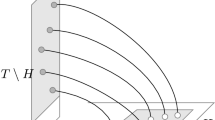Abstract
We introduce the notion of an extension set for an affine plane of order q to study affine designs \({\mathcal {D}}'\) with the same parameters as, but not isomorphic to, the classical affine design \({\mathcal {D}} = \mathrm {AG}_2(3,q)\) formed by the points and planes of the affine space \(\mathrm {AG}(3,q)\) which are very close to this geometric example in the following sense: there are blocks \(B'\) and B of \({\mathcal {D}'}\) and \({\mathcal {D}}\), respectively, such that the residual structures \({\mathcal {D}}'_{B'}\) and \({\mathcal {D}}_B\) induced on the points not in \(B'\) and B, respectively, agree. Moreover, the structure \({\mathcal {D}}'(B')\) induced on \(B'\) is the q-fold multiple of an affine plane \({\mathcal {A}}'\) which is determined by an extension set for the affine plane \(B \cong AG(2,q)\). In particular, this new approach will result in a purely theoretical construction of the two known counterexamples to Hamada’s conjecture for the case \(\mathrm {AG}_2(3,4)\), which were discovered by Harada et al. [7] as the result of a computer search; a recent alternative construction, again via a computer search, is in [23]. On the other hand, we also prove that extension sets cannot possibly give any further counterexamples to Hamada’s conjecture for the case of affine designs with the parameters of some \(\mathrm {AG}_2(3,q)\); thus the two counterexamples for \(q=4\) might be truly sporadic. This seems to be the first result which establishes the validity of Hamada’s conjecture for some infinite class of affine designs of a special type. Nevertheless, affine designs which are that close to the classical geometric examples are of interest in themselves, and we provide both theoretical and computational results for some particular types of extension sets. Specifically, we obtain a theoretical construction for one of the two affine designs with the parameters of \(\mathrm {AG}_2(3,3)\) and 3-rank 11 and for an affine design with the parameters of \(\mathrm {AG}_2(3,4)\) and 2-rank 17 (in both cases, just one more than the rank of the classical example).




Similar content being viewed by others
Notes
Not even a single counterexample is known, and the only proven instances are the few cases in which actually the conjecture in its strong version has been established, which all require \(q=2\) or \(q=3\).
See [2, §XII.5] for results and references concerning good blocks in general incidence structures. Other authors use the term prime block instead.
As the discussion of the special case \({\mathcal {D}}=\mathrm {AG}_2(3,4)\) given in [23, §4] shows, \({\mathcal {E}}\) may have further resolutions. However, these are of no interest to us.
References
Assmus Jr. E.F., Key J.D.: Designs and their Codes. Cambridge University Press, Cambridge (1992).
Beth T., Jungnickel D., Lenz H.: Design Theory, 2nd edn. Cambridge University Press, Cambridge (1999).
Blokhuis A., Haemers W.H.: An infinite family of quasi-symmetric designs. J. Stat. Plan. Inference 95, 117–119 (2001).
Clark D.C., Jungnickel D., Tonchev V.D.: Affine geometry designs, polarities, and Hamada’s conjecture. J. Comb. Theory (A) 118, 231–239 (2011).
Hamada N.: On the \(p\)-rank of the incidence matrix of a balanced or partially balanced incomplete block design and its application to error correcting codes. Hiroshima Math. J. 3, 153–226 (1973).
Hamada N., Ohmori H.: On the BIB-design having the minimum \(p\)-rank. J. Comb. Theory Ser. A 18, 131–140 (1975).
Harada M., Lam C.W.H., Tonchev V.D.: Symmetric (4,4)-nets and generalized Hadamard matrices over groups of order 4. Des. Codes Cryptogr. 34, 71–87 (2005).
Hirschfeld J.W.P.: Projective Geometries over Finite Fields, 2nd edn. Oxford University Press, Oxford (1998).
Jungnickel D.: The number of designs with classical parameters grows exponentially. Geom. Dedicata 16, 167–178 (1984).
Jungnickel D.: Recent results on designs with classical parameters. J. Geom. 101, 137–155 (2011).
Jungnickel D., Tonchev V.D.: Polarities, quasi-symmetric designs, and Hamada’s conjecture. Des. Codes Cryptogr. 51, 131–140 (2009).
Jungnickel D., Tonchev V.D.: Maximal arcs and quasi-symmetric designs. Des. Codes Cryptogr. 77, 365–374 (2015).
Kantor W.M.: Symplectic groups, symmetric designs and line ovals. J. Algebr. 33, 43–58 (1975).
Kimberley, M.E.: On the construction of certain Hadamard designs. Ph. D. thesis, University of London (1968).
Kimberley M.E.: On the construction of certain Hadamard designs. Math. Z. 119, 41–59 (1971).
Lam C., Tonchev V.D.: Classification of affine resolvable 2-(27,9,4) designs. J. Stat. Plan. Inference 56, 187–202 (1996).
Lunelli L., Sce M.: Considerazioni aritmetiche e resultati sperimentali sui \(\{K, n\}_q\) archi. Ist. Lombardo Accad. Sci. Lett. Rend. A 98, 3–52 (1964).
Mavron V.C., McDonough T.P., Tonchev V.D.: On affine designs and Hadamard designs with line spreads. Discret. Math. 308, 2742–2750 (2008).
Polverino O., Zullo F.: Codes arising from incidence matrices of points and hyperplanes in \(PG(n,q)\). arXiv:1606.02222 (2016).
Shrikhande S.S.: Generalized Hadamard matrices and orthogonal arrays of strength two. Can. J. Math. 16, 736–740 (1964).
Tonchev V.D.: Quasi-symmetric 2-(31, 7, 7)-designs and a revision of Hamada’s conjecture. J. Comb. Theory Ser. A 42, 104–110 (1986).
Tonchev V.D.: Combinatorial Configurations. Wiley, New York (1988).
Tonchev V.D.: Linearly embeddable designs. Des. Codes Cryptogr. (2016). doi:10.1007/s10623-016-0304-6.
Acknowledgements
The authors wish to thank the three anonymous reviewers for their careful reading of the manuscript and their helpful comments. In particular, thanks are due to one of the reviewers for pointing out an error in our original proof of Corollary 2.9 and for providing Example 2.4. Yue Zhou: Research supported by a grant of the Alexander von Humboldt Foundation. Vladimir D. Tonchev: Research partially supported by NSA Grant H98230-16-1-0011.
Author information
Authors and Affiliations
Corresponding author
Additional information
Communicated by J. D. Key.
Rights and permissions
About this article
Cite this article
Jungnickel, D., Zhou, Y. & Tonchev, V.D. Extension sets, affine designs, and Hamada’s conjecture. Des. Codes Cryptogr. 86, 587–610 (2018). https://doi.org/10.1007/s10623-017-0344-6
Received:
Revised:
Accepted:
Published:
Issue Date:
DOI: https://doi.org/10.1007/s10623-017-0344-6



